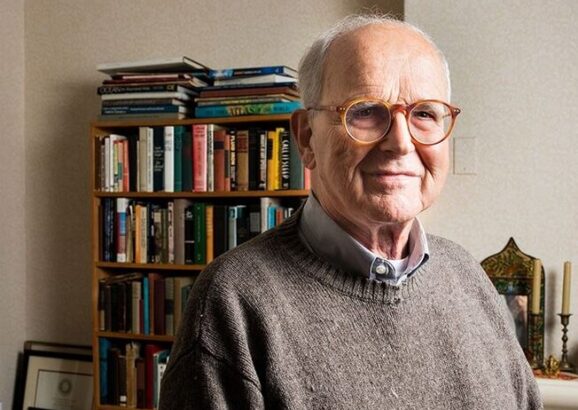Rainer Weiss '55 PhD '62
2017 Nobel Laureate
Research Interests
Writing this at 73 and having shed the august responsibilities of a full fledged faculty, it is natural to be retrospective rather than to look at prospects.
Currently working on the LIGO project, a joint Caltech and MIT effort, to observe gravitational waves and use them to study gravitation and astrophysics. My role now is to be the equivalent of a grad student. Very much enjoy this. Over the years have worked on cosmological studies with Robert Dicke and David Wilkinson at Princeton. Began physics in atomic beams with John King and Jerrold Zacharias at MIT. If you are really interested, you can read the standard stuff.
More info:
Courtesy of MIT School of Science | YouTube
Major Projects
- Atomic Clock development
- Balloon program to measure Cosmic Background Radiation
- Science Working Group Chairman, COBE satellite program
- Laser Interferometer Gravitational-Wave Observatory (LIGO)
Biographical Sketch
RAINER WEISS SB ’55; PhD ’62 (NAS) is a Professor Emeritus at Massachusetts Institute of Technology (MIT). Previously Dr. Weiss served as an assistant physics professor at Tufts University and has been an adjunct professor at Louisiana State University since 2001. Dr. Weiss is known for his pioneering measurements of the spectrum of the cosmic microwave background radiation, his inventions of the monolithic silicon bolometer and the laser interferometer gravitational wave detector and his roles as a co-founder and an intellectual leader of both the COBE (microwave background) Project and the LIGO (gravitational-wave detection) Project. He has received numerous scientific and group achievement awards from NASA, an MIT excellence in teaching award, the John Simon Guggenheim Memorial Foundation Fellowship, the National Space Club Science Award, the Medaille de l’ADION Observatoire de Nice, the Gruber Cosmology Prize, and the Einstein Prize of the American Physical Society. Dr. Weiss is a fellow of the American Association for the Advancement of Science, the American Physical Society, The American Academy of Arts and Sciences; and he is a member of the American Astronomical Society, the New York Academy of Sciences, and Sigma Xi. He received his B.S. and Ph.D. in physics from MIT. Dr. Weiss is a member of the NAS and has served on nine NRC committees from 1986 to 2007 including the Committee on NASA Astrophysics Performance Assessment; the Panel on Particle, Nuclear, and Gravitational-wave Astrophysics; and the Task Group on Space Astronomy and Astrophysics.
Courtesy of Nobel Prize | YouTube

MIT physicist Rainer Weiss shares Nobel Prize in physics
LIGO inventor and professor emeritus of physics recognized “for decisive contributions to the LIGO detector and the observation of gravitational waves.”
Awards & Honors
- 2020 // American Astronomical Society Legacy Fellow
- 2018 // Joseph Weber Award for Astronomical Instrumentation (AAS) "For his invention of the interferometric gravitational-wave detector, which led to the first detection of long-predicted gravitational waves from astronomical sources by the Laser Interferometer Gravitational-wave Observatory (LIGO)."
- 2017 // Nobel Prize in Physics (LIGO, co-recipient with Barry C. Barish and Kip S. Thorne)
- 2017 // Princess of Asturias Award for Technical and Scientific Research (LIGO)
- 2017 // Willis E. Lamb Award for Laser Science and Quantum Optics (LIGO)
- 2016 // Harvey Prize in Science and Technology (LIGO)
- 2016 // Kavli Prize in Astrophysics (co-recipient with Ronald W.P. Drever and Kip S. Thorne) (LIGO) "For the direct detection of gravitational waves.”
- 2016 // Shaw Prize in Astronomy (LIGO) (co-recipient with Ronald W P Drever and Kip S Thorne) "for conceiving and designing the Laser Interferometer Gravitational-Wave Observatory (LIGO), whose recent direct detection of gravitational waves opens a new window in astronomy, with the first remarkable discovery being the merger of a pair of stellar mass black holes."
- 2016 // Gruber Prize in Cosmology (LIGO) "for the first detection of gravitational waves."
- 2016 // Special Breakthrough Prize in Fundamental Physics (LIGO)
- 2007 // Einstein Prize (APS) ""For fundamental contributions to the development of gravitational wave detectors based on optical interferometry, leading to the successful operation of the Laser Interferometer Gravitational Wave Observatory."
- 2006 // Gruber Prize in Cosmology (as part of COBE team) "for studies confirming that our universe was born in a hot Big Bang."
- 2003 // Medaille de l'ADION Observatoire de Nice
- 2000 // National Academy of Sciences Member
- 2000 // John Simon Guggenheim Memorial Foundation Fellowship
- 1998 // American Academy of Arts and Sciences Fellow
- 1996 // American Physical Society Fellow "For his pioneering work in the development of laser-interferometric detectors for gravitational radiation, and his contributions to the study of the spectrum and anisotropy of the cosmic microwave background."
- 1994 // National Space Club Science Award (COBE)
- 1991 // NASA Group Achievement Medal (COBE)
- 1991 // NASA Exceptional Scientific Achievement Medal (COBE)
- 1990 // NASA/GSFC Group Achievement Award (COBE)
- 1983 // NASA Achievement Award (Monolithic Bolometers)
- 1968 // Baker Award for Excellence in Teaching (MIT)
Key Publications
-
“Detector Description and Performance for the First Coincidence Observations between LIGO and GEO,” The LIGO Scientific Collaboration, Nucl. Instrum. Methods A, 517, 154-179 (2004).
-
“Analysis of LIGO data for gravitational waves from binary neutron stars,” LIGO Scientific Collaboration, Phys Rev D 69, 122001 (2004).
-
“Setting upper limits on the strength of periodic gravitational waves using the first science data from the GEO600 and LIGO detectors,” LIGO Scientific Collaboration, Phys Rev D 69, 082004 (2004).